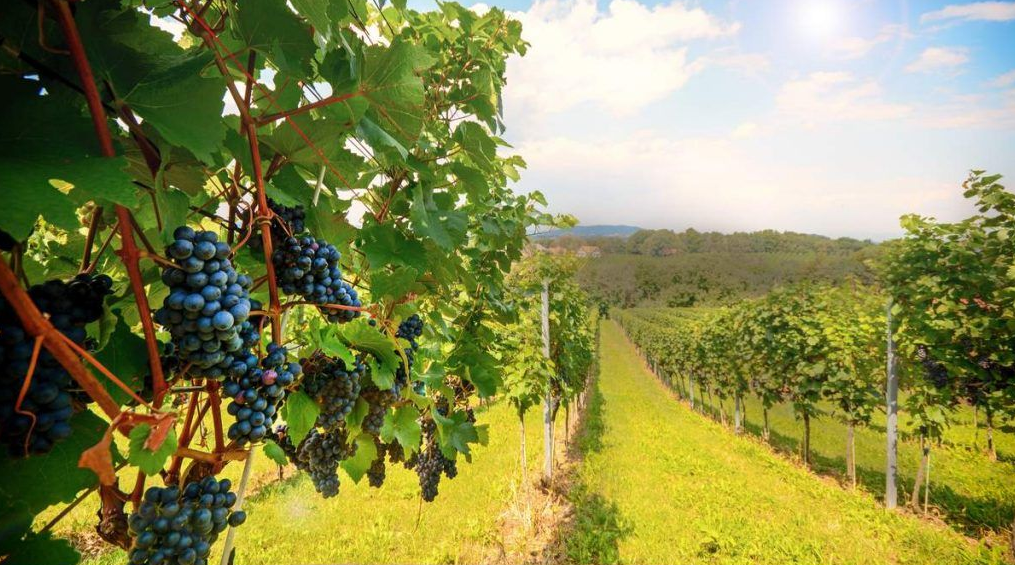
If you are a wine lover, Wine Route node Chile is a destination that should be on your travel list. With its three producing regions known worldwide – Maipo Valley, Casablanca Valley and Colchagua Valley – the Wine Route is a true paradise for wine tasting and unique wine tourism experiences.
To the wineries Chileans are internationally acclaimed for their high-quality wines and landscapes stunning natural landscapes that stretch throughout the territory. Each wine-producing region has its own unique characteristics, offering visitors the opportunity to sample a variety of wines, from light whites to robust reds.
In this article, we will present the three producing regions most famous of Wine Route node Chile and what each of them has to offer. If you're planning a trip to South America, you certainly shouldn't miss the opportunity to sample the best of Chilean wines.
Main Conclusions:
- The Wine Route in Chile is an unmissable destination for wine lovers.
- The region is made up of three producing regions known worldwide: Maipo Valley, Casablanca Valley and Colchagua Valley.
- Each wine-producing region has its own unique characteristics, offering visitors the opportunity to sample a variety of wines, from light whites to robust reds.
- To the wineries Chileans are internationally acclaimed for their high-quality wines and landscapes stunning natural landscapes that stretch across the entire territory.
- The Chilean Wine Route is a true paradise for wine tasting and unique wine tourism experiences.

Discover the Maipo Valley
For wine lovers, the Maipo Valley is a must-see region to explore when visiting Chile. Located near the capital Santiago, the Maipo Valley is known for its wineries renowned, which produce some of the best wines in the country.

Among the most famous wineries in the Maipo Valley region are: Concha y Toro, Saint Rita, From Martino and UndurragaEach winery has its own charm, but they all share a commitment to the quality of the wine they produce. Whether on a guided tour or over lunch at one of the wineries, there's plenty to explore and enjoy in the Maipo Valley.
Grapes from the Maipo Valley
Various grapes are cultivated in the Maipo Valley region, but the highlight is the grapes reds. Carménère, Cabernet Sauvignon, Syrah, and Merlot are some of the varieties grown in the region's wineries. These grapes thrive in the hot, dry climate of the Maipo Valley, producing red wines full-bodied and complex.
Although red grapes are the most cultivated in the region, there are also plantations of white grapes, such as Chardonnay and Sauvignon Blanc, which are used to produce white wines fresh and aromatic.
Wine tourism highlights
In addition to tasting the award-winning wines produced in the Maipo Valley, visitors can enjoy a range of activities wine tourism in the region. Wineries offer a variety of experiences, from vineyard tours to tastings in underground cellars.
One of the most popular experiences of wine tourism In the Maipo Valley, you can participate in the grape harvest during the harvest season. This is a unique opportunity to experience wine production up close and learn about the winemaking process.
Another option is a bike tour of the wineries, exploring the landscape and stopping for tastings along the way. There are also wine-paired lunch options at winery restaurants, offering a complete gastronomic experience.
Award-winning wines and stunning scenery in the Maipo Valley
In the Maipo Valley, visitors can enjoy award-winning wines and landscapes stunning landscapes, making the region one of the most popular on Chile's Wine Route. Local wineries are known for producing high-quality wines that win over discerning palates worldwide.
Among the most renowned wineries in the Maipo Valley, Concha y Toro and Viña Santa Rita stand out, offering tours of the vineyards and tastings of their wines. award-winning winesVisitors can also sample local cuisine at the restaurants that accompany the wineries.
The Maipo Valley region is known for its production of Cabernet Sauvignon, Syrah, and Carménère grapes. The region's Mediterranean climate, with well-defined seasons and dry periods, is ideal for growing these grape varieties.

| Award-winning wines | Landscapes |
|---|---|
| Concha y Toro: Don Melchor Cabernet Sauvignon, voted Best Red Wine at the 2019 Brussels World Contest. | The Maipo Valley is surrounded by the Andes Mountains, offering stunning panoramic views throughout the region. |
| Viña Santa Rita: Triple C, recognized by Descorchados Guide 2021 as the best iconic wine in Chile. | Visitors can enjoy a stroll through the vineyards amidst breathtaking natural scenery. |
| Viña Undurraga: TH Terroir Hunter Cabernet Franc, voted Best Wine of the Year at the Wine & Spirits Top 100 awards in 2019. | The region's vineyards are bathed by the Maipo River, creating a unique and welcoming atmosphere. |
The Maipo Valley is a must-see experience for wine lovers looking to enjoy award-winning wines amidst stunning landscapes in Chile.

The charm of the Casablanca Valley
THE Casablanca Valley is one of the most charming wine regions in Chile and attracts many visitors interested in wine tourism. With around 80 wineries in its area, the region is famous for producing white wines and high quality reds.

Casablanca Valley Wineries
Among the best-known wineries in the Casablanca Valley are Viña Casas del Bosque and Emiliana Organic Vineyards. In addition to offering wine tastings and vineyard tours, the region's wineries also have restaurants offering offer experiences unique gastronomic options, pairing dishes with local wines.
Wine tourism in the Casablanca Valley
Visitors to the Casablanca Valley can enjoy a variety of wine tourism experiences, including guided winery tours, wine tastings, picnics, and horseback riding. The region's natural setting, surrounded by mountains and mild climate, makes the experience even more enjoyable.
White wines from the Casablanca Valley
The Casablanca Valley is known for producing excellent white wines, especially those made with Sauvignon Blanc and Chardonnay grapes. These wines have a fruity flavor and mineral notes, making them perfect with seafood dishes or salads.
Hosting
To fully enjoy the Casablanca Valley Wine Route, it's recommended to spend at least one night in the region. Accommodation options include a variety of options, from luxury hotels to charming guesthouses. Some wineries also offer accommodations in cottages or cabins, providing a more intimate experience surrounded by nature.
Transport
One of the most practical ways to reach the Casablanca Valley is by car. Leaving Santiago, the region is about 50 kilometers away. However, it's also possible to hire transfer services or take a tour with a specialized agency.

White wines and a mild climate in the Casablanca Valley
The Casablanca Valley is a unique wine region in Chile, known for its remarkable white wines and mild climate.
The region benefits from a cool Mediterranean climate with maritime influences, making it ideal for growing white grapes such as Chardonnay and Sauvignon Blanc. These grapes produce elegant, aromatic wines with floral and fruity notes.
Chardonnay
Chardonnay is the most widely cultivated white grape in the Casablanca Valley and produces wines with a wide variety of flavors and aromas. Most winemakers in the region choose to ferment and age Chardonnay in French oak barrels, which gives the wines a unique complexity, with notes of vanilla and toast.
Sauvignon Blanc
Sauvignon Blanc is another white grape popularly grown in the Casablanca Valley. Wines made from this grape are fresh and vibrant, with notes of citrus, apple, and passion fruit.
In addition to white wines, the Casablanca Valley is also known for its red wines lighter and fruitier, like Pinot Noir. The mild climate The region is ideal for growing this delicate grape, which produces elegant, fresh wines with notes of red fruits.
| Grape | Flavor | Aroma |
|---|---|---|
| Chardonnay | Tropical fruits, toasted | Apple, peach, vanilla |
| Sauvignon Blanc | Citrus, tropical fruits | Passion fruit, grapefruit, lemon |
| Pinot Noir | Red fruits | Blackberry, cherry, spices |
“The combination of a mild climate and cool, fertile soil makes the Casablanca Valley a unique region for white wine production.”
Visitors can enjoy unique wine tourism experiences in the Casablanca Valley, including visits to award-winning wineries, wine tastings, and vineyard tours. The region is easily accessible from Santiago, making it a popular option for tourists looking to explore Chile's wine and gastronomy.
- To sample the best white wines in the Casablanca Valley, visit Viña Casas del Bosque, Emiliana Organic Vineyards, and Viña Veramonte.
- The best time to visit the region is in late spring and early summer, when the vineyards are in full growth and the weather is most pleasant.
- Wineries often offer lodging options, allowing visitors to make the most of their wine tourism experience.
In short, the Casablanca Valley is a must-visit wine region for white wine lovers. With its mild climate, fertile, cool soil, and high-quality grape varieties, it's one of Chile's finest wine regions.
The Colchagua Valley and its robust red wines
THE Colchagua Valley is one of the most renowned wine regions in Chile, known for its red wines Robust and full-bodied. The region is located about 130 km south of Santiago and is home to some of the country's most renowned wineries.
When visiting the Colchagua Valley, wine lovers can enjoy a unique experience exploring the region's diverse wineries. Some of the most famous wineries include Viña Montes, Viu Manent, Lapostolle, and Santa Cruz.

Red wines
Red wines are the specialty of the Colchagua Valley. The most commonly grown grapes are Carmenere, Cabernet Sauvignon, and Syrah.
Carmenere is a grape that has adapted perfectly to the dry, hot climate of the Colchagua Valley. When grown in ideal conditions, it produces red wines with fruity and spicy notes.
Cabernet Sauvignon is a grape variety that produces red wines with a more intense and elegant flavor. Syrah, on the other hand, produces full-bodied red wines with notes of red fruits and spices.
Wineries
There are many wineries to visit in the Colchagua Valley. Each has its own unique characteristics and offers a unique experience. Some wineries offer vineyard tours, while others have restaurants and hotels on their properties. Below is a list of some of the most famous wineries in the Colchagua Valley:
| Viña Montes | Founded in 1988, Viña Montes is one of the most renowned wineries in the Colchagua Valley. The winery is known for its premium red wines and impressive architecture from your cellar. |
|---|---|
| Viu Manent | Viu Manent is a family-owned winery with over 80 years of history. The winery is known for its award-winning red wines and for offering horseback rides through the vineyards. |
| Lapostolle | Lapostolle is a winery that combines tradition and innovation. The winery is renowned for its high-quality red wines and its modern, sustainable architecture. |
| Santa Cruz | Santa Cruz is a winery offering a complete experience, including vineyard tours, museums, and cable cars. The winery is known for its red wines and hospitality. |
Regardless of which winery you choose, visitors to the Colchagua Valley can expect an enriching experience, learning about the region's winemaking history and tasting some of Chile's finest wines.
The flavors and aromas of the Colchagua Valley
The Colchagua Valley region is known for its robust red wines, produced from grapes grown in clay soils and a Mediterranean climate typical of the region. These natural conditions, combined with the expertise of local producers, result in exceptional wines, rich in flavors and aromas unique.
The most widely grown grape varieties in the Colchagua Valley are Carmenere, Cabernet Sauvignon, and Syrah. These grapes are known for producing full-bodied, complex wines with notes of red and black fruits, spices, and hints of oak from barrel aging.
The flavors of the Colchagua Valley
The red wines produced in the Colchagua Valley are known for their richness of flavors and complexity. Local producers strive to create wines that reflect the personality of the terroir, with flavors that vary depending on the grape variety, the winemaking process, and the length of barrel aging.
Carmenere, for example, produces wines with notes of herbs, pepper, and ripe red fruits, while Cabernet Sauvignon offers fuller-bodied flavors with notes of dark fruits and spices. Syrah, known for its intense and peppery flavor, produces complex wines with notes of black fruits, pepper, and chocolate.
The aromas of the Colchagua Valley
The wines produced in the Colchagua Valley are also known for their aromas Intense and characteristic. The fermentation and barrel aging processes help to accentuate these aromas, which vary depending on the grape variety and aging time.
Wines made from Carmenere grapes can feature aromas of ripe red fruits, spices, and hints of tobacco. Wines made from Cabernet Sauvignon grapes feature aromas of black fruits, such as cassis and blackberry, as well as notes of pepper and eucalyptus. Syrah, on the other hand, produces wines with aromas of black fruits, chocolate, vanilla, and spices.
“The wines produced in the Colchagua Valley are an experience for the senses, with flavors and aromas that reflect the richness of the terroir and the expertise of local producers.”
The wine tourism experience on the Wine Route
The Wine Route in Chile provides a wine tourism experience unique and unforgettable. Visitors have the opportunity to visit some of the best wineries in the world, as well as enjoy the natural beauty of Chilean landscapes.
Activities available to tourists include wine tastings, guided winery tours, bike rides through the vineyards, and much more. Additionally, it's possible to sample the local cuisine, which is known for its incredible dishes and exceptional wine pairings.
Examples of wine tourism activities on the Wine Route:
| Activity | Description |
|---|---|
| Visit to the Concha y Toro winery | One of Chile's most famous wineries, with tours and wine tastings available to visitors. |
| Colchagua Valley Bike Tour | A fun and active way to explore the Colchagua region and its wineries. |
| Dinner at a local restaurant | Experience Chilean food and wine pairings at one of the region's many restaurants. |
Regardless of the activity chosen, the wine tourism experience on the Wine Route is truly incomparable.
Tips for making the most of Chile's Wine Route
If you're planning a trip to explore Chile's Wine Route, check out these tips useful to make the most of your wine tourism journey.
Ideal time to visit
The best time to visit Chile's Wine Route is during the harvest, which occurs between March and May. However, the region is charming year-round, so don't worry if you can't travel during that time.
Transport
To fully enjoy the Wine Route, we recommend renting a car. This will allow you to visit the wineries at your own pace and stop at restaurants and tourist attractions along the way.
Reservations
Before visiting wineries, be sure to make reservations in advance. Many wineries require reservations for tours and tastings.
Tour packages
If you prefer a more organized experience, consider booking a tour package. These typically include transportation and visits to select wineries, as well as tastings and meals.
Try the local cuisine
Take advantage of your visit to the Wine Route to sample delicious Chilean cuisine. Many wineries have on-site restaurants offering local dishes paired with regional wines.
Hosting
There are many accommodation options along the Wine Route, from luxurious hotels to cozy guesthouses. Consider staying at a winery for an immersive winemaking and tasting experience.
Taste different grape varieties
Don't limit yourself to one type of grape or wine during your visit to the Wine Route. Try different grape varieties and wine styles to discover your favorites and better understand the diversity of wine production in the region.
The promising future of the Wine Route in Chile
The Wine Route in Chile has a promising future ahead, with continued efforts to improve the region's wine industry. The three wine-producing regions highlighted in this article—Maipo Valley, Casablanca Valley, and Colchagua Valley—are constantly investing in technology and innovation to produce high-quality wines and further improve the wine tourism experience for its visitors.
One of the major changes in recent years on the Chilean Wine Route has been the emphasis on sustainability. Wineries in the region are adopting more environmentally friendly practices, from responsible water management to renewable energy production. This is important not only to ensure the long-term survival of the industry but also to preserve natural beauty of the area.
Furthermore, the Wine Route is becoming increasingly accessible to international visitors. The Chilean government is investing in infrastructure to make the region easier to reach, with the construction of new roads, airports, and train stations. Wineries are also offering more accommodation options, from large resorts to cozy local guesthouses.
The numbers of the wine industry in Chile
| Year | Wine exports (in millions of liters) | Export revenues (in billions of dollars) |
|---|---|---|
| 2016 | 708 | 1,98 |
| 2017 | 704 | 2,07 |
| 2018 | 746 | 2,91 |
| 2019 | 819 | 3,30 |
The figures show that the Chilean wine industry is constantly expanding, with a significant increase in exports in recent years. This is good news for the Wine Route, which plays a key role in producing quality wines for the international market.
In short, the Wine Route in Chile has a promising future ahead. With investments in sustainability, infrastructure, and innovation, wineries are producing high-quality wines and offering increasingly better wine tourism experiences. There's no doubt that Chile's Wine Route will continue to captivate wine lovers from around the world.
The seductive power of the Wine Route
The Wine Route in Chile is not only a destination for wine lovers, but also an invitation to explore stunning landscapes, sample gastronomy local and immerse yourself in the culture Chilean. The perfect combination of these elements is what makes the Wine Route such a seductive destination.
In each of the wine-producing regions – Maipo Valley, Casablanca Valley and Colchagua Valley – visitors have the opportunity to visit some of the world's most renowned wineries, taste award-winning wines and learn about the winemaking process.
In the Maipo Valley, red wines made from Carmenere and Cabernet Sauvignon grapes are a highlight, while in the Casablanca Valley, white wines made from Chardonnay and Sauvignon Blanc grapes dominate. In the Colchagua Valley, full-bodied red wines win over visitors' palates.
But it's not just wine that makes the Wine Route a seductive destination. The mountainous landscapes, vineyards stretching for miles, lush valleys, and unforgettable sunsets are an invitation to appreciate the natural beauty from Chile.
And, of course, Chilean cuisine is a delight for visitors' palates. With a blend of indigenous, Spanish, and French influences, Chilean dishes are a unique sensory experience that pairs perfectly with local wines.
With so many seductive elements, the Chilean Wine Route is a destination that will surely remain in the memory of all visitors. Discover it for yourself. power of seduction of the Wine Route and enjoy a unique wine tourism experience in Chile.

Conclusion
Chile's Wine Route is undoubtedly a must-see destination for wine lovers from around the world. Throughout this article, we explore three of the country's most renowned wine-producing regions: the Maipo Valley, the Casablanca Valley, and the Colchagua Valley. Each of these regions has distinct characteristics that contribute to the production of high-quality wines and offer unique wine tourism experiences.
In addition to highlighting the wineries and wines produced in each of these regions, we also discuss the stunning landscapes, activities available to visitors, and share tips practices to make the most of the Wine Route in Chile.
The future of Chile's Wine Route is promising, with advances in the wine industry and opportunities for growth. But the Wine Route's charm lies in its perfect combination of wine, gastronomy, and stunning landscapes, making this journey an unforgettable experience for all visitors.
We hope this article has inspired you to plan your own journey along Chile's Wine Route and enjoy all the wine tourism experiences the country has to offer.
Take advantage of every opportunity to taste award-winning wines, visit renowned wineries and explore the natural beauty from Chile. Don't forget to follow our tips practices to make the most of your trip.
Don't waste any more time and start planning your trip along Chile's Wine Route right now. You can be sure it will be a memorable one. unforgettable experience, full of flavors, aromas and stunning landscapes.
FAQ
What is the Wine Route?
The Wine Route is a tourist route in Chile that allows visitors to explore the country's wine regions, visit renowned wineries, taste award-winning wines, and enjoy stunning scenery.
What are the three producing regions explored in this article?
The three producing regions explored in this article are the Maipo Valley, the Casablanca Valley and the Colchagua Valley.
What is the Maipo Valley?
The Maipo Valley is one of Chile's most famous wine regions, known for its renowned wineries, high-quality grapes, and wine tourism experiences.
What to expect from the Casablanca Valley?
The Casablanca Valley is a charming wine region in Chile, known for its remarkable white wines and a mild climate conducive to growing high-quality grapes.
What is the Colchagua Valley?
The Colchagua Valley is known for its robust red wines, acclaimed wineries, and lush landscapes, providing a unique experience for visitors.
What activities are available on the Wine Route?
On the Wine Route, visitors can enjoy wine tastings, winery visits, vineyard tours, and a variety of other wine tourism experiences.
What are the best times to visit the Wine Route in Chile?
The best times to visit Chile's Wine Route are during the grape harvest, which generally occurs between February and April, and during spring and summer, when the vines are in full growth.
What are your tips for making the most of Chile's Wine Route?
Some tips for making the most of Chile's Wine Route include researching and planning your visit in advance, sampling different wine varieties, exploring the different wine-producing regions, and sampling the delicious local cuisine.
How is the Wine Route in Chile evolving?
Chile's Wine Route is constantly evolving, with advances in technology and winemaking practices, as well as growth opportunities for the region's wine industry.
What makes the Wine Route so seductive?
The perfect combination of wine, gastronomy and stunning landscapes makes the Chilean Wine Route irresistible for wine lovers and those looking to enjoy a unique wine tourism experience.
Lucas Wanderlust has a tireless spirit of adventure, always seeking new travel experiences. Fascinated by the world and the possibility of exploring unknown destinations, he fell in love with the sense of freedom and self-discovery that traveling alone provides. With a backpack on his back and a heart open to the unknown, Lucas embarks on exciting journeys, where each destination becomes a unique chapter in his life story. He gives himself body and soul to the magic of solo travel, inspiring others to follow in his footsteps and discover themselves through adventure.







